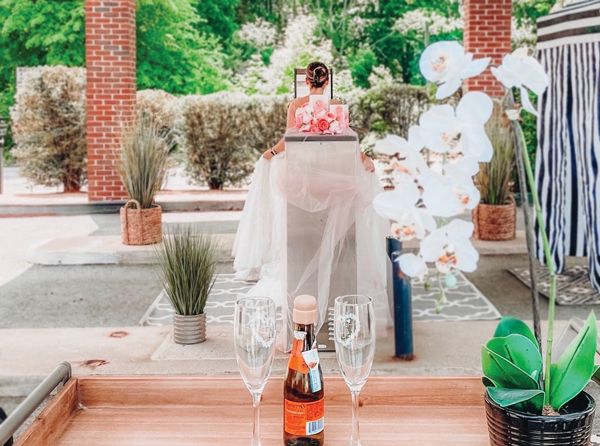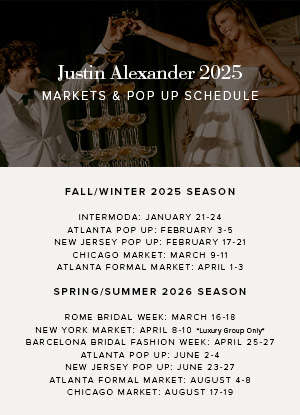During the COVID-19 closures, many boutiques began brainstorming creative ideas for keeping both brides and stylists healthy once they received the green light to reopen.
While common safety measures include requiring masks, steam cleaning dresses in between appointments, limiting the number of guests, staggering appointments and providing complimentary sanitizer, many salons have also been compelled to reimagine and reconfigure their use of space for merchandising purposes.
Following are six innovative ways you are doing so. . .
The Great Outdoors
Forget tailgating at football games this season: how about tailgating at the bridal shop instead?
Tulle Bridal in Andover, Mass., is fortunate enough to have a parking lot adjacent to its shop complete with a covered portico, a remnant from a former bank building. Though brides who opt for the traditional indoor shopping experience are limited to two guests, brides who choose the Outdoor Experience are allowed to bring up to six guests and can bring their own food and drinks for a makeshift tailgate party.
There is a canopy for them to change in, as well as chairs and a mirror; dresses are brought outside. Even though the weather does not always cooperate and it’s a two-stylist job, the Outdoor Experience, which is available on weekends only, has been a popular way to bring some sense of normalcy to the bridal shopping experience.
“It’s a lot of fun,” says owner Heidi Janson. “That has been going over well!”
Raise Your (Plexi)glass!
Within two days of being shut down, Kleinfeld in Manhattan, N.Y., made the decision to be proactive in redoing its salon for the safety of its brides and 250 employees. Working seven days a week over a period of three months, the construction team was able to install plexiglass at strategic locations throughout the store.
For example, as more than 100 employees normally work in Kleinfeld’s alterations department, the boutique installed plexiglass to the right, left and in front of the workers, who are also stationed seven feet apart, explained owner Ronnie Rothstein, adding that they have only been allowed to bring back half the staff to date, per state mandate.
In addition to installing a hospital-level filtration system to create a clean environment, Kleinfeld also reconfigured its entire salon.
“One of the things that has made Kleinfeld so successful is that brides can see each other in dresses,” says Rothstein, referring to The Grand Salon, which is viewable from all points in the store. “Our concern was to be able to keep that same concept of bringing the bride into the main salon but somehow socially distancing them.”
The solution? The bridal area is now sectioned off with wooden partitions that resemble fine furniture, set apart by plexiglass panels that create a safety zone and a semblance of privacy.
And the reception area can accommodate up to three-person bridal parties sitting in private, socially distant sections without sacrificing brides’ view, also sectioned off with plexiglass. Plexiglass has been installed at the front desk area as well.
“When you walk in from the reception area, you still have the view of this magnificent, large grand salon,” Rothstein says. “While everything is private and socially distant, we still kept the salon as open as it had been.”
The Untouchables
Because shoppers tend to touch merchandise, Megan Dumaine, owner of the Wedding Embassy in Oakville, Conn., removed all non-saleable tactile items and contained all jewelry in glass boxes. However, as part of the sales process involves allowing brides to look through the racks, Dumaine lets customers touch the dresses using gloves handed out by consultants.
At Ever After Bridal in Chattanooga, Tenn., the store requests that the bride’s guests – limited to two – help dress her rather than the consultant.
This has been a difficult change, because, as manager Catilyn Howze says, “We are very personable; we love to touch and shake hands. Typically, during an appointment, we go into the room and dress our brides, but now we don’t get that same one-on-one personal time with them.”
Before the pandemic, Kleinfeld brides, like most brides, tossed their clothes and shoes on a dressing room chair. Now, to decrease the possibility of contamination, Kleinfeld provides a shopping bag that contains a silk robe. Brides are instructed to place clothing in the bags, which can be taken home as a keepsake of their shopping experience; the silk robes are returned and dry-cleaned that day.
Process of Elimination: Furniture and Food
Because most shops are only allowing one or two guests per bride, many have made changes to their seating arrangements as well as the types of chairs they offer.
The Victorian couches that guests lounged in at Something Bleu in Saratoga Springs, N.Y. have been put away for the time being.
“One of the first things we did was remove all couches and shared seating from our space, which meant that we basically pared it down to two chairs in each dressing room to accommodate each guest and filled a spare dressing room with excess furniture,” says Kathryn Metzler, who co-owns the salon with Marissa Mackay.
Likewise, the Wedding Embassy removed the plush, velvety benches, replacing them with vinyl seating, as it is easier to clean.
The furniture and bridal pedestals in the main salon at Kleinfeld were reconfigured to accommodate social distancing guidelines: before the pandemic, it was able to accommodate eight areas but that was cut back to seven. The store has also closed its coat room at this time.
Fortunately, Mon Amie in Orange County, Calif., is large enough that owner Laurel Mungo did not have to change too much, as, at 12,000 square feet, it was easy enough for customers to keep their distance in her salon. However, she did eliminate two of the four chairs normally at each pedestal and mirror, spacing the two remaining chairs six feet apart.
On the sales floor, Metzler and Mackay removed six of their 12 mannequins because “…dressing and undressing the mannequins is a lot of effort and makes it harder to clean and keep everything sanitary,” Metzler says. “Taking a lot of them away created more space and made things cleaner.”
The mannequins currently on the floor display dresses that do not get tried on frequently.
On a separate note, many boutiques have also at least temporarily curtailed their refreshment offerings. For example, a fun experience at Tulle Bridal was the candy buffet, but Janson had to remove that for safety; she also eliminated champagne toasts.
These little sweet touches will likely come back with time in many areas, although for now they remain a casualty of the pandemic.
Workflow and Traffic Patterns
The Wedding Embassy is housed in an old, industrial building, and while its owner loves the open, airy feeling, she’s had to divide up the shopping areas to keep parties physically separate.
“I think really the hardest part is not physical, but changing your mind to adjust to the physical changes,” Dumaine says. “You can move the space around but it is hard to wrap your head around bookings so that appointments are spaced out; moving traffic flow in the store so that the waiting area only has one group; and that appointments are separate and no one is in the racks at the same time.”
At Tulle Bridal, guests have to stay in the car until they are called in to the salon and directed to one main entrance; once inside, they are directed to follow a designated path throughout the store, and when they leave, they exit through a different door. Appointments are also staggered so that multiple people are not arriving at the same time.
Mungo said that because the store is no longer able to accommodate walk-ins, the front door remains locked, a big change from pre-COVID days.
At Kleinfeld, security guards are stationed out front to both take temperature checks and maintain traffic flow throughout the 35,000-square-foot store. Only customers who have not come from hot spot areas are allowed into the store at this time unless they can document that they’ve been in New York for 14 days. The floors are clearly marked with painted circles designating where customers should stand so that they are six feet apart from others.
To remind customers of the new safety requirements in place, the store has placed whimsical signs throughout, such as a sketch of a bride that says: Please Social Distance: Please stay at least 6 feet away from other parties at all times. What’s 6 feet? Just imagine a very long dress train! Another sign depicts a sketch of a hand with a ring and says: Practice Hand Hygiene: Please help yourself to the complimentary hand sanitizer available throughout the store so you can keep your hands (and your ring) sparkling.
Fitting Room Adjustments
Something Bleu created two new types of appointments: one is a fully virtual appointment with an at-home try-on.
“For the other, we transformed one of our dressing suites into a Zoom Room: We brought in a big TV, got a web cam, and set it up so that they can have as many virtual guests as they want,” says Metzler, adding that these appointments have been popular, particularly for brides with large parties.
In addition, every fitting room has its own set of cleaning supplies in a basket along with a state-mandated cleaning log.
“We bought rose gold automatic dispensers for hand sanitizer in the dressing suites to match our aesthetic, and we just generally tried to make all these very sterile additions feel as authentic and welcoming as it’s possible to be when everyone is wearing masks and keeping appropriate distance,” Mackay says.
Mon Amie also set up the ability to Zoom meetings in one of the bridal rooms, though Mungo says that not too many brides are taking advantage of this option.
Dumaine loved the communal fitting rooms in her shop, the Wedding Embassy. But because of COVID, she hung blackout curtains to partition one room into separate dressing rooms.
“Though we took away something that made the space feel unique, we are fortunate enough to have the space to divide so we can get employees back to work and we can still have multiple appointments without having people on top of each other,” she says.
And at Tulle Bridal, Janson also switched out dressing rooms so that they are not side by side, leaving some socially distanced room between them.




























